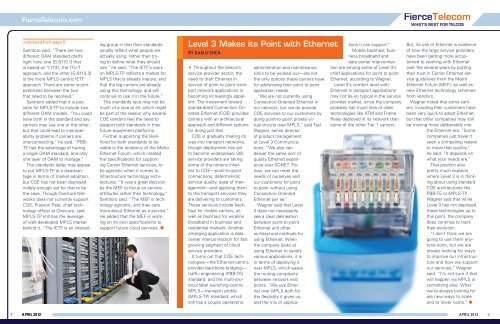Connection Oriented Ethernet - InfoVista
Connection Oriented Ethernet - InfoVista
Connection Oriented Ethernet - InfoVista
Create successful ePaper yourself
Turn your PDF publications into a flip-book with our unique Google optimized e-Paper software.
FierceTelecom.com<br />
continued from page 5 Level 3 Makes its Point with <strong>Ethernet</strong><br />
Santitoro said. “There are two<br />
different OAM standard drafts<br />
right now, one [G.8113.1] that<br />
is based on Y.1731, the ITU-T<br />
approach, and the other [G.8113.2]<br />
is the more MPLS-centric IETF<br />
approach. There are some incompatibilities<br />
between the two<br />
that need to be resolved.”<br />
Santitoro added that it is possible<br />
for MPLS-TP to include two<br />
different OAM models. “You could<br />
have both in the standard and say<br />
carriers may use one or the other,<br />
but that could lead to interoperability<br />
problems if carriers are<br />
interconnecting,” he said. “PBB-<br />
TE has the advantage of having<br />
a single OAM standard, and only<br />
one layer of OAM to manage.”<br />
The standards delay may appear<br />
to put MPLS-TP at a disadvantage<br />
in terms of market adoption,<br />
but COE has not been deployed<br />
widely enough yet for that to be<br />
the case. Though Overture Networks<br />
does not currently support<br />
COE, Prayson Pate, chief technology<br />
officer at Overture, said<br />
MPLS-TP still has the leverage<br />
of well-developed MPLS market<br />
behind it. “The IETF is an interest-<br />
ing group in that their standards<br />
usually reflect what people are<br />
actually using, rather than trying<br />
to define what they should<br />
use,” he said. “The IETF’s work<br />
on MPLS-TP reflects a market for<br />
MPLS that is already mature, and<br />
that the big carriers are already<br />
using this technology, and will<br />
continue to use it in the future.”<br />
The standards race may not be<br />
much of a race at all, which might<br />
be part of the reason why several<br />
COE vendors feel the need to<br />
support both standards in their<br />
future equipment platforms.<br />
Further supporting the likelihood<br />
for both standards to be<br />
viable is the tendency of the Metro<br />
<strong>Ethernet</strong> Forum, which created<br />
the specifications for supporting<br />
Carrier <strong>Ethernet</strong> services, to<br />
be agnostic when it comes to<br />
infrastructure technology architectures.<br />
“It was a great decision<br />
by the MEF to focus on service<br />
attributes rather than technology,”<br />
Santitoro said. “The MEF is technology<br />
agnostic, and they care<br />
more about <strong>Ethernet</strong> as a service.”<br />
He added that the MEF is working<br />
on its own specifications to<br />
support future cloud services. l<br />
BY DAN O’SHEA<br />
� Throughout the telecom<br />
service provider sector, the<br />
need to draft <strong>Ethernet</strong> in<br />
service of point to point transport<br />
network applications is<br />
becoming increasingly apparent.<br />
The movement toward<br />
standardized <strong>Connection</strong>-<strong>Oriented</strong><br />
<strong>Ethernet</strong> (COE) provides<br />
carriers with an architectural<br />
approach and different options<br />
for doing just that.<br />
COE is gradually making its<br />
way into transport networks,<br />
though deployment has yet<br />
to become widespread. Still,<br />
service providers are taking<br />
some of the notions inherent<br />
to COE—point-to-point<br />
connections, deterministic<br />
service quality, ease of management—and<br />
applying them<br />
to the transport services they<br />
are delivering to customers.<br />
These services include backhaul<br />
for mobile carriers, as<br />
well as backhaul for wireline<br />
broadband in business and<br />
residential markets. Another<br />
emerging application is data<br />
center interconnection for fast<br />
growing segment of cloud<br />
service providers.<br />
It turns out that COE technologies—the<br />
<strong>Ethernet</strong>-centric<br />
provider backbone bridging—<br />
traffic engineering (PBB-TE)<br />
standard, and the multi-protocol<br />
label switching-centric<br />
MPLS—transport profile<br />
(MPLS-TP) standard, which<br />
still has a couple operations,<br />
administration and maintenance<br />
kinks to be worked out—are not<br />
the only options these carriers have<br />
for addressing their point to point<br />
application needs.<br />
“We are not currently using<br />
<strong>Connection</strong>-<strong>Oriented</strong> <strong>Ethernet</strong> in<br />
our network, but we do provide<br />
COE services to our customers by<br />
doing point-to-point private virtual<br />
circuits over MPLS,” said Ted<br />
Wagner, senior director<br />
of product management<br />
at Level 3 Communications.<br />
“We also can<br />
deliver the same sort of<br />
quality <strong>Ethernet</strong> experience<br />
over SONET. For<br />
now, we can meet the<br />
needs of ourselves and<br />
our customers for point<br />
to point without using<br />
<strong>Connection</strong>-<strong>Oriented</strong><br />
<strong>Ethernet</strong> per se.”<br />
Wagner said that Level<br />
3 does not necessarily<br />
see a clear delineation<br />
between point-to-point<br />
<strong>Ethernet</strong> and other<br />
architectural methods for<br />
using <strong>Ethernet</strong>. When<br />
the company looks at<br />
using <strong>Ethernet</strong> to satisfy<br />
various applications, it is<br />
in terms of deploying it<br />
over MPLS, which eases<br />
the routing complexity<br />
between network end<br />
points. “We use <strong>Ethernet</strong><br />
over MPLS both for<br />
the flexibility it gives us,<br />
and the mix of applica-<br />
tions it can support.”<br />
Mobile backhaul, business<br />
broadband and<br />
data center interconnection<br />
are among some of Level 3’s<br />
chief applications for point to point<br />
<strong>Ethernet</strong>, according to Wagner.<br />
Level 3’s comfort level with<br />
<strong>Ethernet</strong> in transport applications<br />
may not be so typical in the service<br />
provider market, since the company<br />
probably has much less of older<br />
technologies like ATM and Frame<br />
Relay deployed in its network than<br />
some of the other Tier 1 carriers.<br />
But, its use of <strong>Ethernet</strong> is evidence<br />
of how the large service providers<br />
have been getting more accustomed<br />
to working with <strong>Ethernet</strong><br />
over the several years by putting<br />
their trust in Carrier <strong>Ethernet</strong> service<br />
guidelines from the Metro<br />
<strong>Ethernet</strong> Forum (MEF), as well as<br />
new <strong>Ethernet</strong> technology schemes<br />
from vendors.<br />
Wagner noted that some carriers,<br />
including their customers have<br />
been very quick to adopt <strong>Ethernet</strong>,<br />
but that other companies may still<br />
be moving more deliberately into<br />
the <strong>Ethernet</strong> era. “Some<br />
companies just haven’t<br />
seen a compelling reason<br />
to move that quickly,”<br />
he said. “It depends on<br />
what your needs are.”<br />
That position also<br />
pretty much explains<br />
where Level 3 is in thinking<br />
about using standard<br />
COE architectures like<br />
PBB-TE or MPLS-TP.<br />
Wagner said that while<br />
Level 3 has not deployed<br />
these technologies up to<br />
this point, the company<br />
does continue to track<br />
their evolution.<br />
“I don’t think we are<br />
going to use them anytime<br />
soon, but we are<br />
always looking for ways<br />
to improve our infrastructure<br />
and how we support<br />
our services,” Wagner<br />
said. “I’m not sure if that<br />
will happen via MPLS or<br />
something else. What<br />
we’re always looking for<br />
are new ways to scale<br />
and to lower costs.” l<br />
7 April 2012<br />
April 2012<br />
8
















